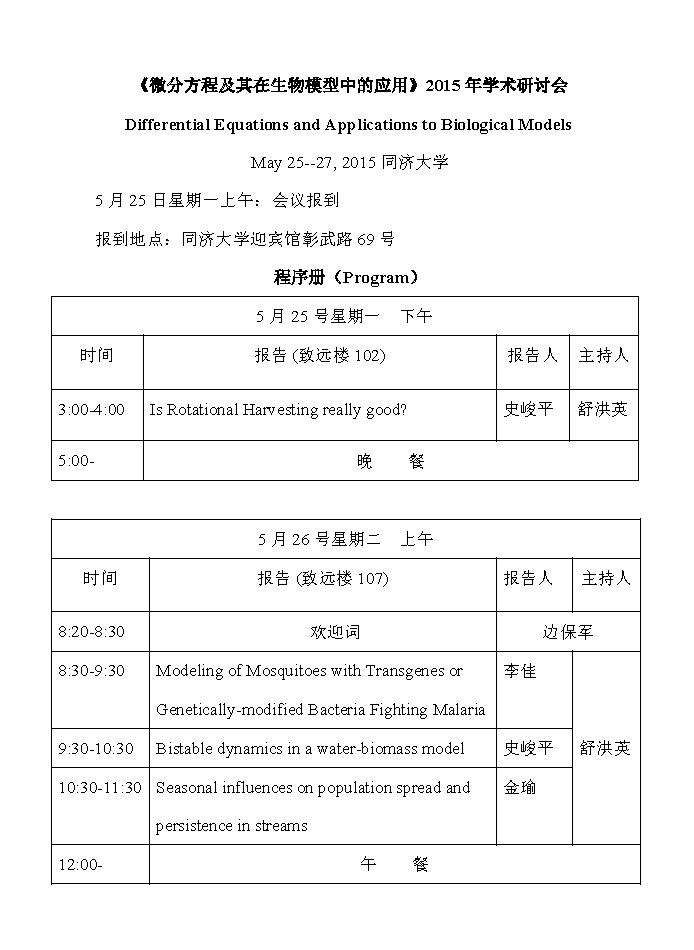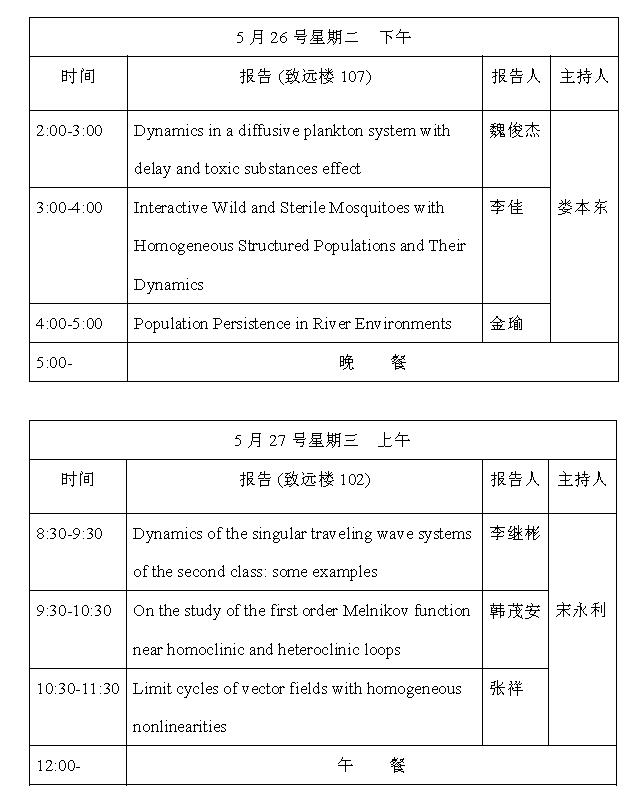

On the study of the first order Melnikov function
near homoclinic and heteroclinic loops
韩茂安
Shanghai Normal University, China
In this talk, we introduce some advances on the expansion of the first order Melnikov function appearing by perturbing a Hamiltonian or integrable system with a homoclinic or heteroclinic loop. We obtain formulas for computing the first coefficients of the expansion which can be used to find a lower bound for the maximal number of limit cycles near the loop based on these coefficients.
Modeling of Mosquitoes with Transgenes or
Genetically-modified Bacteria - Fighting Malaria
李佳
University of Alabama in Huntsville, USA
To prevent malaria transmission, genetically-altered (transgenic) mosquitoes, or mosquitoes carrying genetically-modified bacteria, that are resistant to malaria infection, become an effective weapon. To study the impact of these mosquitoes mixing with wild mosquitoes on the malaria transmission, we formulate simple mathematical models of interactive wild and transgenic mosquitoes, based on systems of difference equations. We consider both dominant and recessive transgenes, or include horizontal and vertical transmissions of genetically-modified bacteria. With fundamental analysis of the model equations, we investigate their interactive dynamics of the different types of mosquitoes, and demonstrate the rich dynamical features of the models by numerical examples.
Interactive Wild and Sterile Mosquitoes with Homogeneous or Stage-Structured Populations and Their Dynamics
李佳
University of Alabama in Huntsville, USA
To prevent the transmission of malaria or other mosquito-borne diseases, an effective weapon is using the sterile insect technique (SIT) to release sterile mosquitoes to reduce or eradicate the wild mosquito population. To study the impact of SIT on the diseases transmission, we formulate simple mathematical models for the interactive wild and sterile mosquitoes with homogeneous or stage-structured populations, incorporating different strategies in releasing sterile mosquitoes. We investigate the model dynamics and compare the different release strategies. Numerical examples are also given to demonstrate rich dynamical features of the models.
Dynamics of the singular traveling wave systems of the second class: some examples
李继彬
Zhejiang Normal University, China
The mathematical modeling of important phenomena arising in physics and biology often leads to nonlinear wave equations. It is quite remarkable that many of these universal equations exhibit a regular behavior, typical of integrable partial differential systems (there exist Hamiltonian structures). And their traveling wave systems are also integrable ordinary differential equations, in which there exist some singular properties. In this talk, we introduce the dynamical behavior for the singular traveling wave systems of the second class. As examples, for some very interesting mathematical models which describe specific natural phenomena, we study the bifurcations and exact solutions of given systems.
Seasonal influences on population spread and persistence in streams
金瑜
University of Nebraska-Lincoln, USA
The drift paradox asks how stream-dwelling organisms can persist, without being washed out, when they are continuously subject to the unidirectional stream flow. To date, mathematical analyses of the stream paradox have investigated the interplay of growth, drift and flow needed for species persistence under the assumption that the stream environment is temporally constant. However, in reality, streams are subject to major seasonal variations in environmental factors that govern population growth and dispersal. We consider the influence of such seasonal variations on the drift paradox, using a time-periodic integro-differential equation model. We establish upstream and downstream spreading speeds under the assumption of periodically fluctuating environments, and also show the existence of periodic traveling waves. We also address the critical domain size problem for seasonally fluctuating stream environments and determine how large a reach of suitable stream habitat is needed to ensure population persistence of a stream-dwelling species. Fluctuating environments are characterized by seasonal correlations between the flow, transfer rates, diffusion and settling rates, and we investigate the effect of such correlations on the population spread and persistence. For a specific dispersal function, we show that the upstream spreading speed is nonnegative if and only if the critical domain size exists in this temporally fluctuating environment.
Population Persistence in River Environments
金瑜
University of Nebraska-Lincoln, USA
To fully understand population persistence in river ecosystems, it is necessary to consider the effect of the water flow. We develop equations that couple hydraulic flow to population growth and analyze them to assess the effect of water flow on population persistence. We establish the net reproductive rate for advection-diffusion-reaction equations in spatially varying environments and derive persistence thresholds for integro-difference equations in the presence of advective flow with both periodic (alternating) and random kernel parameters. We provide methods to calculate these measures and apply the measures to population persistence in rivers under various flow regimes.
Is Rotational Harvesting really good?
史俊平
College of William and Mary, USA
It is a common understanding that rotational cattle grazing provides a better yield than continuous grazing, but a qualitative analysis is lacking in the agriculture literature. In rotational grazing, cattle periodically move from one paddock to another in contrast to continuous grazing, in which the cattle graze on a single plot for the entire grazing season. Here we quantitatively show how production yields and stockpiled forage are greater in rotational grazing in some harvesting models. We construct a vegetation grazing model on a fixed area, and by using parameters obtained from agricultural publications and keeping the minimum value of remaining forage constant, our result shows that both the number of cattle per acre and stockpiled forage increase for all tested rotational configurations than the continuous grazing. Some related spatial harvesting models are also discussed. This is a joint work with Mayee Chen (Jamestown High School).
Bistable dynamics in a water-biomass model
史俊平
College of William and Mary, USA
Pattern formation of water-biomass interaction systems in the semi-arid climatic zone have been considered by many ecologists and mathematicians. Here we propose a new model of water and plant interaction with possible effect of diffusion, advection and cross-diffusion. First we rigorously analyze the corresponding kinetic ODE model, which reveals rich dynamics including backward equilibrium bifurcation, forward/backward Hopf bifurcation, homoclinic bifurcation and Bogdanov-Takens bifurcation. Secondly we show the spatial-temporal pattern formation of the spatial model. This model could serve as an explanation of the sudden desertification of arid regions. This is a joint work with Xiaoli Wang and Guohong Zhang (Southwest University).
Dynamics in a diffusive plankton system with delay and toxic substances effect
魏俊杰
Harbin Institute of Technology, China
The dynamics of a reaction-diffusion plankton system with delay and toxic substances effect is considered. Existence and priori bound of solution for model without delay are shown. Globally asymptotically stability of the axial equilibrium is obtained. The stability of the positive equilibrium and the existence of Hopf bifurcation are investigated by analyzing the distribution of the eigenvalues. And the properties of Hopf bifurcation is determined by the normal form theory and the center manifold reduction for partial functional differential equations. Some numerical simulations are carried out for illustrating the theoretical results.
Limit cycles of vector fields with homogeneous nonlinearities
张祥
Shanghai Jiao Tong University, China
In this talk I introduce my results on limit cycles for planar polynomial differential equations with linear plus homogenous nonlinearity of degree n larger than 1. Most known results above these equations, valid for arbitrary n, deal with the case where the origin is a focus or a node and give either non-existence of limit cycles or upper bounds of one or two limit cycles surrounding the origin. Here we improve some of these results and moreover we show that for n no less than 3 odd there are equations of this form having at least (n+1)/2 limit cycles surrounding the origin. Our results include cases where the origin is a focus, a node, a saddle or a nilpotent singularity.

 会议室预约入口
会议室预约入口 "智能计算与应用"8858cc永利唯一官方网数学中心
"智能计算与应用"8858cc永利唯一官方网数学中心 English
English